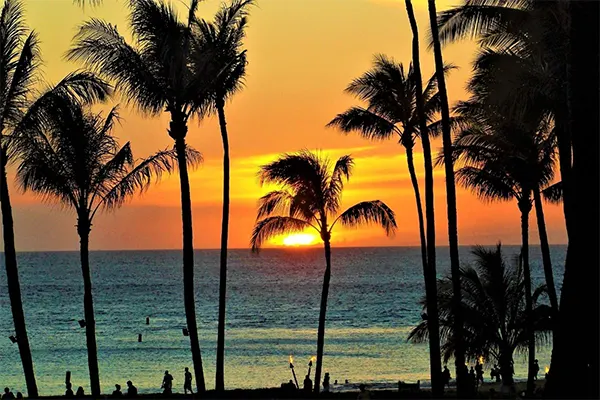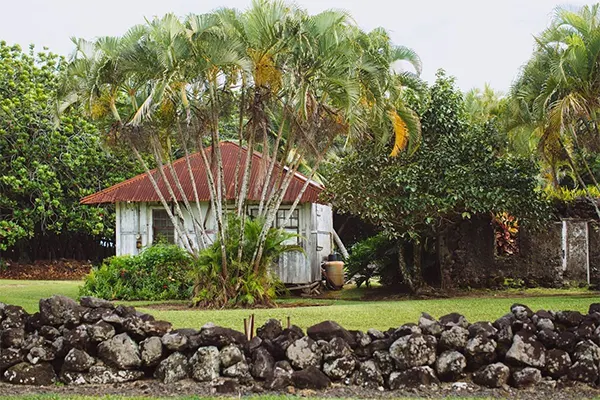Found across the island, state parks give visitors an opportunity to discover the varied landscape of Maui.
With locations on South Maui, East Maui, West Maui, and across the Road to Hana, Maui state parks are a low-cost (sometimes free!) adventure to add to the itinerary.
Learn more about state parks in Maui with this guide.

Haleki’i-Pihana Heiau State Monument
Table of Contents
The 10-acre Haleki’i-Pihana Heiau State Monument is best known for containing two heiau.
Heiau are sites of great importance to native Hawaiians, and they were associated with the chiefs of pre-contact Hawaii.
A visit to Haleki’i-Pihana Heiau State Monument offers a rare chance to get close to a part of Maui that’s now mostly lost.
The two heiau of the park—Haleki’i and Pihana—are thought to possibly date back to 1260.
The park is free to enter and open to pedestrians only. Haleki’i-Pihana Heiau State Monument offers scenic views of Wailuku and is a fantastic place for a picnic or afternoon stroll.
‘Iao Valley State Monument
With rich tropical flora and a diverse landscape, there’s lots to see at the ‘Iao Valley State Monument.
But the stand-out is the impressive ‘Iao Needle, a rock formation that juts up 1200 feet high.
Among the West Maui Mountains, the ‘Iao Needle gained importance due to its association with Kanaloa, god of the ocean, due to its slightly phallic nature.
The trails of the ‘Iao Valley State Monument are lush with native planting, and the heritage gardens introduce the cultures of modern Hawaii.
Open from 7am to 6pm and with a $5 entrance fee, ‘Iao Valley State Monument has hiking, backpacking, and majestic scenery, plus public bathrooms and picnic tables.
There’s also a parking fee, which is determined by the size of the vehicle.
Makena State Park
Tucked along the far coast of South Maui, Makena State Park is home to Big Beach and Little Beach, otherwise known as Oneloa Beach and Pu’u Olai Beach.
Visitors head to Big Beach for the swimming and sunbathing, plus a chance to try the tacos from the nearby food trucks.
Little Beach, on the other hand, is best known as the Maui home of nude bathing.
Makena State Park also offers the starting point of several trails, which take you across the lava fields formed by Maui’s volcanic explosions.
At the center of the park is Pu’u Olai, a 360-foot dormant volcano cinder cone.
Makena has a $5 entrance fee, and a $10 parking fee.
(And check out our guide to the best Makena Beach Hotels.)

Wai’anapanapa State Park
There are more than a few reasons to visit Wai’anapanapa State Park, but the biggest attraction tends to be the black sand beaches.
Formed from the cooled lava of Maui’s many volcanic eruptions, the small black pebbles aren’t great for sunbathing, but do make for a breathtaking sight.
Especially when combined with the lava tubes, caves, and natural stone sculptures of the landscape.
Also, keep an eye out for the tide pools, which can turn red at different times of the year.
Wai’anapanapa State Park requires a reservation for entry, which can be made via gowaianapanapa.com.
Entrance costs $5 per person, with an additional parking fee depending on the size of car.
Pua’a Ka’a State Wayside
22 miles along the Hana Highway is Pua’a Ka’a State Wayside Park, a waterfall park that can be tricky to spot if you don’t know what you’re looking for.
Open from 6am to 6pm daily, Pua’a Ka’a State Wayside follows a series of small waterfalls, winding their way to a larger waterfall that marks the end of the trip.
As well as waterfalls and pools, you might also stumble across some mongooses!
Pua’a Ka’a State Wayside is an attractive park that also marks a good place for a bathroom break thanks to the free entrance.
Many visitors make use of the picnic trails and visit the small waterfalls on the paved trail, but neglect the dirt road to the larger falls.
Wailua Valley State Wayside
It’s easy to overlook the Wailua Valley State Wayside, a park past mile marker #18 on the Road to Hana.
With limited parking spaces (although one of them is ADA accessible), many cars drive right past without stopping.
However, you have to get out of the car to discover the set of stairs that lead you to the look-out point.
Make the short climb, and you’ll find exceptional panoramic views across to the village of Wailua, to the Ko’olau Gap, and over the Ke’anae Valley.
Wailua Valley State Wayside is a quick stop that offers a chance to stretch your legs, get some air, and enjoy the changing scenery of Maui.
Kaumahina State Wayside
The 7.8 acres of Kaumahina State Wayside offer visitors to the Road to Hana a chance to stretch their legs as they tackle the early stages of the drive. It’s also a good place for a bathroom break!
But Kaumahina State Wayside is more than just convenient. The biggest attraction of the area is the scenic coastal lookout.
Which offers exceptional views of the ocean across to the Ke’anae Peninsula. Take your binoculars, and spot the native plants and birds.
Kaumahina State Wayside is open from 6am to 6pm daily, with an $8 entrance fee.
Polipoli Spring State Recreation Area
There are four trails across the Polipoli Spring State Recreation Area, each offering a different view of Maui.
The Haleakala Ridge Trail passes through scrub and grassland, showing a glimpse of Maui’s volcanic past.
The Plum Trail gets its name from the plum trees that litter the forest route.
The Polipoli Trail takes hikers through the planted conifers, while the Redwood Trail features towering trees and an old ranger’s cabin.
With a high elevation, hikers at Polipoli should dress up warm, and in bright colors to avoid the hunters. There’s no entrance fee, but there is a fee to camp.
Visiting Maui’s State Parks
Many of the state parks are a must-see for Maui visitors, and low entrance fees make them widely accessible.
Visiting the state parks can offer you unique views of the Maui landscape, from the open beaches of Makena, to the dense woodland of Polipoli, and the unusual forms of ‘Iao Valley.
